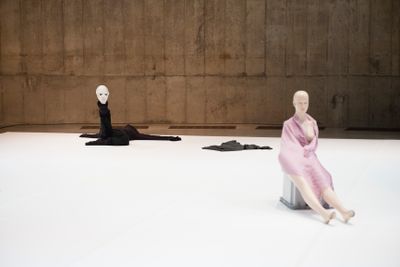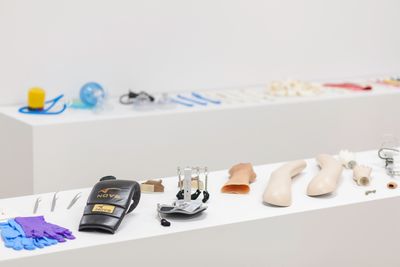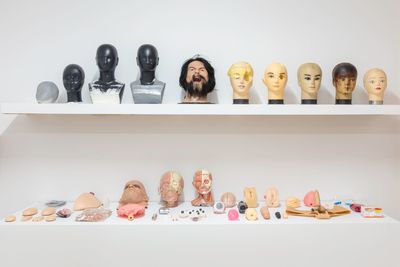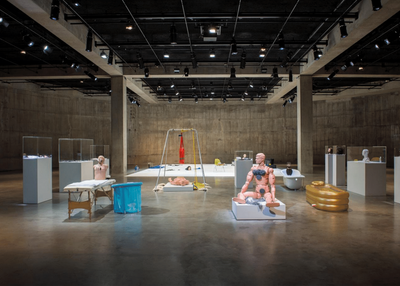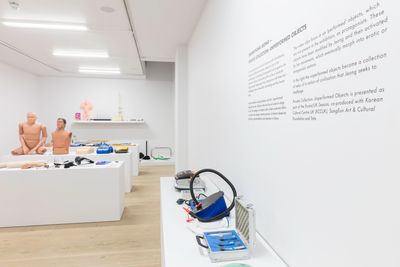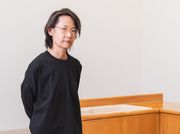Geumhyung Jeong
Geumhyung Jeong. Courtesy Delfina Foundation. Photo: Tae Hwan Kim.
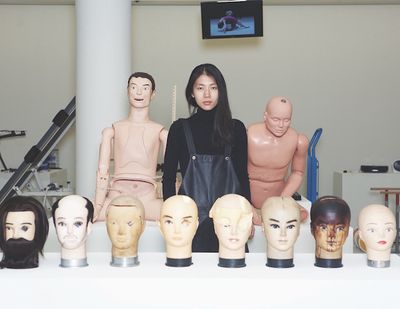
Geumhyung Jeong. Courtesy Delfina Foundation. Photo: Tae Hwan Kim.
Puppets, mannequins, machines, and reassembled objects have been essential to the practice of South Korean choreographer and performance artist Geumhyung Jeong since her first performance in 2004. Jeong sees these objects as 'collaborators', and colloquially refers to each in the third person as 'he' or 'him', while adopting the term 'duet' to describe her performances, in which she creates erotic narratives. In her performance-lecture Oil Pressure Vibrator (2008), Jeong turns a construction machine into her object of desire. In Fitness Guide (2011), exercise machines become erotic partners during physical training routines, while in CPR Practice (2013) she manipulates and controls stationary dummies to evoke sensual gestures. In 7ways, which was developed from her first performances between 2004 and 2009, Jeong disguised her foot with a mask and used it to act out the role, seeking affection from a mannequin.
Despite the dizzying array of ways that technology has permeated our lives—raising both expectations and concerns about the porous boundaries between the realms of man and machine—Jeong invites her mechanistic props into the most intimate spheres of human existence, creating emotional and sexual bonds with them. In doing so, her performances cut through and complicate a number of boundaries—flesh and plastic, control and voyeurism, imagination and reality.
Expanding from her previous focus on performing with objects on stage, Jeong has started to exhibit her props in gallery spaces, thereby blurring the boundaries between performance and exhibition. This trend was initiated by her 2016 exhibition Private Collection at Atelier Hermès in Seoul, an opportunity Jeong gained after receiving the 16th Hermès Foundation Missulsang Award, along with a residency in France. Once denizens of the backstage, Jeong's props were put centre stage at Atelier Hermès, displaying the broad range that Jeong has used in her performances, from sex toys—including air dolls, dildos, and mutilated mannequins—to sporting goods and miniatures of construction equipment.
While her initial Private Collection exhibition at Atelier Hermès incorporated props from her previous shows without differentiating whether they had been used in performances or not, the subsequent Private Collection: Unperformed Objects at Delfina Foundation (28 September–11 November 2017) included objects that have not been used previously. These included dismantled mannequins, anatomical models and electronic gadgets like vacuum cleaners.
Jeong's exhibition at Delfina Foundation coincided with her participation in Tate Modern's Live programme (2–8 October 2017), which created an opportunity for the artist to demonstrate the two core facets of her artistic practice—exhibition and performance—in one space. Inside one of Tate Modern's Tanks spaces, Jeong displayed the props for 7ways (2009)—including a seated mannequin and pieces of fabric—on a performance stage alongside the video installation Munbangu (Stationary) (2011). This video shows a series of elongated pencils, erasers, and brushes, which protrude through the mouth of a miniature male figure, who then proceeds to sketch, erase and paint a female body. Also on view was the new installation Spa & Beauty (2017), for which Jeong demonstrates massage techniques on a mannequin attached to a massage table. During the daytime, the stage for 7ways was open to the public as an exhibition space, while it morphed into a performance platform in the evening. Such malleability corresponds with Jeong's previous artistic trajectory, which traverses performance and installation, stage and gallery.
In this conversation, the artist discusses the incorporation of exhibition-making into her practice, her collecting of props and her relationship with her audience.
HCThroughout your career, you have been very flexible in adapting your works into different spaces—namely the theatre, where you have enacted performances with various props, and more recently, the gallery. Your 2016 exhibition Private Collection at the Atelier Hermès in Seoul, for example, marked an expansion from your previous practice. What has motivated this transition from theatre to gallery? How has it shaped your art in general?
GJOnce I had an opportunity to hold an exhibition in a gallery, I contemplated what I could do with the space. I conceptualised an arrangement that would allow objects to perform without a performer while being in harmony with both the gallery space and the context. The fruit of deliberation was my exhibition entitled Private Collection held in 2016 at the Atelier Hermès in Seoul. For this exhibition, I arranged the objects along a carefully managed path, where both the flow of the exhibition and the audience followed a static axis through the space. On the other hand, for my second exhibition Private Collection: Unperformed Objects at Delfina Foundation, I reworked this display strategy to make best use of the exhibition space. Rather than limiting the objects to a linear narrative, I decided to arrange them in the exhibit so that they were interconnected in all directions, regardless of where the viewer started. It took me quite a while to come to a final decision on a number of different arrangements.
HCCould you please provide more information about your exhibition and performance at Tate Modern? Given the breadth of your body of work, was there any particular reason that you chose to perform 7ways?
GJTate Modern had the final say in selecting which work would be performed. We discussed including the live performance 7ways, the video installation Munbangu (Stationary), and a new installation with demonstrations, Spa & Beauty in Tate Modern's gallery space the Tanks.
I wanted the objects in Spa & Beauty to be shown in the format of a museum collection while 7ways was a performance designed for theatre spaces. As such, we arranged it so that during the day, the gallery opened a stage area for the performance of 7ways as an installation alongside the two aforementioned exhibitions in conjunction with my live demonstration for Spa & Beauty. The objects in Spa & Beauty were exhibited alongside a stage during the day, while the stage space was used for the performance of 7ways in the evening. Thus my installations supplemented each other through this recurring daily cycle, morphing from a gallery for exhibition to a theatre stage for performance. This transition was appropriate not only to introduce my works, but also integrated well with the characteristics of the space in the Tanks.
HCIn your Private Collection exhibition at the Atelier Hermès, you incorporated props from your previous shows without differentiating whether they had been used in performances or not. However, in the recent Private Collection: Unperformed Objects at Delfina Foundation, you narrowed down to focus solely on 'unperformed objects'—props which never made it into a live performance. What drove you to refine the exhibition and how did it influence each exhibition? How does it connect with your plans for your future exhibitions?
GJWhen I prepared the first Private Collection at Atelier Hermès in 2016, my initial idea was to unveil 'unperformed objects'—props which I had collected but did not have the chance to use for any performances. More specifically, my original plan was to juxtapose used and unused objects that had originally been slated to be utilised in each performance.
However, as the idea developed, it became more important for me to mix and rearrange the objects entirely. Drawing from collections of objects that I purchased for a certain purpose, I tried to look past their intended use and rearrange them so that they could create a certain narrative through arrangement and composition. During this process, the numbers of objects kept burgeoning, which had an influence on the format of the exhibition. Therefore, as my approach focused more on the order and arrangement of props rather than their classification, I decided not to draw a distinction between performed and unperformed objects.
Yet at the same time, I have always considered unperformed objects as the hidden protagonists of my exhibitions. Because I did not have a chance to show them on stage, the Private Collection exhibitions were an opportunity for me to introduce them to the public. Moreover, I could tout the wide range of objects that were under consideration, almost as if it was saying 'there is more than what you have seen in the stage'.
In my second Private Collection showing at Delfina Foundation, I needed to compress the size of the show to adjust to the new gallery space. As I considered the criteria on which objects to include, I decided to go back to my previous idea of focusing on 'unperformed objects'. By using this criterion, I could begin to consider future developments and refinements for the Private Collection series. Unlike most props, which I dismantle and rebuild for performances, I displayed the objects as they were, and did not make any modifications from when I first purchased them. The unmodified objects might be able to be used someday or might even remain unused. This new format for the Private Collection exhibition at Delfina Foundation opened up new realms of possibility and flexibility, allowing me to endlessly change the format of the exhibition through different reiterations of the theme.
HCAs we have discussed, the props that you collected for your performance comprise a central role in your two Private Collection shows and in Spa & Beauty as well. How did you start collecting and using objects in your work? Do you have a set criteria when it comes to deciding which objects to adopt in your shows?
GJMy decision-making process on which objects to collect and utilise for the show varies each time. However, such decisions are important as they influence the direction and content of my performances. I began collecting objects when I prepared my first solo performance in 2004 which became the first scene of 7ways in 2009. In some occasions, I purchased the same object twice. For example, I bought the same model of vacuum cleaner twice, and utilised one of them for 7ways, while I exhibited the other at a show at Delfina Foundation as it was not used during any performances. Thus, my unperformed objects continue to accumulate for various reasons. I believe these unperformed objects possess endless possibilities that can be incorporated and set apart from past and future performances.
HCYou are known to make a real effort to develop specific skills for each performance. For example, you learned how to drive an excavator for Oil Pressure Vibrator and devised the show __itness Guide based on your previous experience as a health trainer. You have also gained certificates for CPR and even practiced piloting drones. How have these various skills related to your performances, and how have these skills influenced your shows?
GJFor the choreography, I usually consider the point of the stage where I should begin and end each movement. Concerning my preparation for each show, I start by collecting information and surveying the topic, the same as anyone else might do. The knowledge gained from this research is helpful in approaching the idea. Sometimes the process of learning itself becomes a part of the content of the show.
HCThroughout your career, you have performed around the world, from Korea to the United States, Australia and England. During this time, you have performed in front of diverse audiences from various countries. How has the audience influenced your exhibitions and performances?
GJIt goes without saying, but the audience always has a huge influence on my performance. I make each show in conjunction with the audiences. Thus for me, they are not only a part of the show but also a significant element necessary to complete it. Audiences influence the show from the minute they make the decision to attend and choose a date and time to reserve their seats. Thus I start each performance by saying 'Shall we do this together?' to the audience in my mind.—[O]


